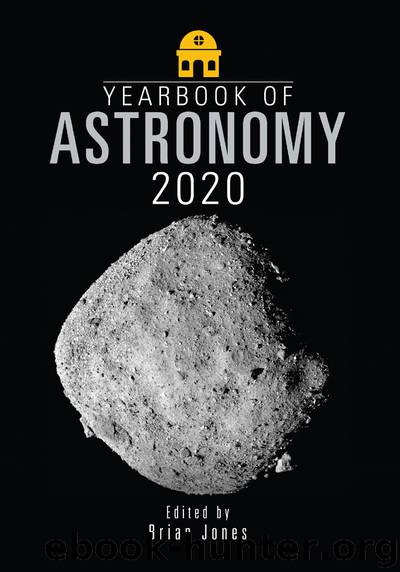Yearbook of Astronomy 2020 by Jones Brian;

Author:Jones, Brian;
Language: eng
Format: epub
Publisher: Casemate Publishers & Book Distributors, LLC
The late 18th and early 19th centuries saw the increasing specialisation of science into specific disciplines such as natural history and geology, and a growing number of people specialising in these fields who wished to communicate and collaborate with their fellow specialists. The Royal Society was still the pre-eminent scientific organisation, but its membership at the time was limited, and could broadly be characterised as being dominated by aristocratic generalists. This led to the establishment of specialised scientific societies in London, such as the Linnean Society (1788) and the Geological Society (1807) (Basalla et al, 1970). Although observational astronomy was flourishing at this time, John Herschel, commenting decades later on the state of the theoretical underpinning of the discipline in the early 19th century, stated that “Mathematics were at the last gasp and Astronomy nearly so”. During this period it was felt that the Royal Society, which once had Isaac Newton as its president, was focused away from mathematics and physical sciences under the long-term presidency of Sir Joseph Banks, a naturalist (Edmunds, 2017a).
It is the Reverend William Pearson (1767–1847) who is credited with proposing, in 1812, a society dedicated to the pursuit of astronomy (Edmunds, 2017c). Eight years later on 12 January 1820, Pearson joined 13 other gentlemen for dinner at the Freemason’s Tavern, Lincoln’s Inn Fields, where they resolved to establish the “Astronomical Society of London”. No professional astronomers from Royal Observatory Greenwich or the universities of Oxford or Cambridge were present at this preliminary meeting; instead the group consisted of men of independent means like Francis Baily, who had made a living as a stockbroker before retiring and dedicating himself to astronomy. The group included members of other professions, such as the clergy (Rev. William Pearson), the law (Daniel Moore) and the military (Captain Thomas Colby). For the next few decades, the membership of the Royal Astronomical Society would continue to be composed of amateur astronomers from the military, clergy and landed gentry, in addition to the increasing number of people who made a living as professional astronomers.
The first president was originally intended to be the Duke of Somerset, but Sir Joseph Banks, who was opposed to the formation of the new society, exerted pressure on the Duke to withdraw. John Herschel’s father, Sir William Herschel, rescued the founders from a difficult situation by agreeing to be the first President, on condition that he would never have to chair a meeting as he was at this time advanced in years. The first meeting of both the Council and the new Society took place on 10 March 1820. The Astronomical Society of London became the Royal Astronomical Society after a Royal Charter was signed by William IV on 7 March 1831.
The original objectives of the Society set out by the founders in the “Address” could be said to be a reflection of their interests in “accurate calculation, extensive record-keeping and establishing enduring standards”, common concerns to those who work in both astronomy and commerce (Edmunds, 2017d). One of
Download
This site does not store any files on its server. We only index and link to content provided by other sites. Please contact the content providers to delete copyright contents if any and email us, we'll remove relevant links or contents immediately.
| Aeronautics & Astronautics | Astronomy |
| Astrophysics & Space Science | Comets, Meteors & Asteroids |
| Cosmology | Mars |
| Solar System | Star-Gazing |
| Telescopes | UFOs |
Tools of Titans by Timothy Ferriss(8214)
Turbulence by E. J. Noyes(7935)
Secrets of Antigravity Propulsion: Tesla, UFOs, and Classified Aerospace Technology by Ph.D. Paul A. Laviolette(5309)
Astrophysics for People in a Hurry by Neil DeGrasse Tyson(5130)
Room 212 by Kate Stewart(5035)
Design of Trajectory Optimization Approach for Space Maneuver Vehicle Skip Entry Problems by Runqi Chai & Al Savvaris & Antonios Tsourdos & Senchun Chai(5011)
Pale Blue Dot by Carl Sagan(4907)
The David Icke Guide to the Global Conspiracy (and how to end it) by David Icke(4624)
A Journey Through Divination and Astronomy by Publishing Pottermore(4341)
Goodbye Paradise(3724)
Apollo 8 by Jeffrey Kluger(3635)
COSMOS by Carl Sagan(3553)
Losing the Nobel Prize by Brian Keating(3498)
The Five People You Meet in Heaven by Mitch Albom(3474)
How to Read Water: Clues and Patterns from Puddles to the Sea (Natural Navigation) by Tristan Gooley(3406)
Brief Answers to the Big Questions by Stephen Hawking(3369)
How to Read Nature by Tristan Gooley(3249)
The Order of Time by Carlo Rovelli(3144)
A Brief History of Time by Stephen Hawking(2959)
